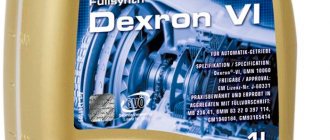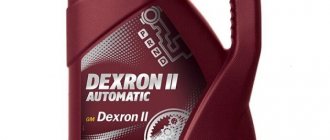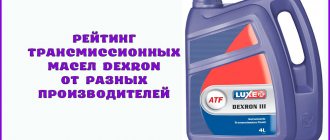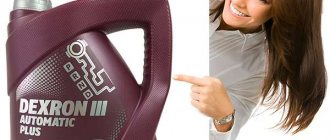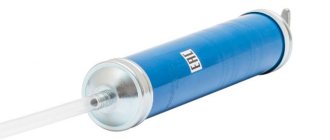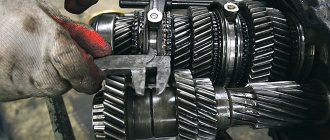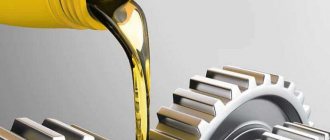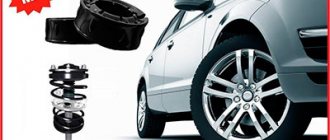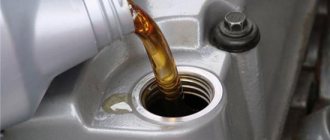In the second half of the 20th century, when the automotive industry became not only widespread, but also international, an urgent need arose for the classification and organization of lubricants.
At this time, the Lubrizol laboratory, owned by one of the leading automotive companies, created a new standard for transmission oils. This standard is called Dexron.
Subsequently, the standard was repeatedly revised and modified. Today, most cars operated in the Russian Federation are designed for the Dextron 3 standard.
Although this standard has been replaced by a more advanced one several years ago. Below we will examine in detail what Dexron 3 lubricants are.
Dexron III/IIIF/IIIG/IIIH
— oils that meet the Dexron III standard or at least one of its modifications; Specific options should be clarified separately in each case. The Dexron standard was developed by General Motors and has long been the main guideline for most manufacturers producing cars with automatic transmissions. Dexron III (IIIF) was introduced in 1993 as a more advanced alternative to Dexron II, while maintaining compatibility with Dexron II boxes (with some exceptions). At the same time, the durability and wear resistance of these oils turned out to be low, so more advanced versions soon appeared: in 1997 - Dexron IIIG with improved low-temperature characteristics, in 2003 - Dexron IIIH with increased resistance to oxidation and scuffing. Official support for all versions of Dexron III was discontinued in 2006, but boxes of this standard and oils for them continue to be produced by third-party manufacturers.
What is Dexron
With the development of the automotive industry in the mid-20th century, standards for automatic transmission oil began to appear. The fluid is called Automatic Transmission Fluid - ATF. The standard described the requirements for fluid composition based on the design features of the gearbox.
General Motors (GM) has been more successful in development than others. The first fluid suitable for all automatic transmissions, Type A fluid, appeared in 1949. After 8 years the specification was updated under the name Type A Suffix A.
In 1967, GM developed the technical standard ATF Dexron type B. The automatic transmission fluid consisted of a stable, hydrotreated base and received anti-foam additives, high heat resistance, and anti-oxidation. The mileage guarantee between replacements was 24,000 miles. The oil was colored red to make it easier to detect leaks.
Sperm whale spermaceti substance was used as friction additives for the first fluids. In 1973, Dexron type II C replaced it with jojoba oil, but the automatic transmission parts quickly rusted. After the problem was discovered, corrosion inhibitors were added to the next generation, Dextron II D, but the automatic transmission fluid quickly aged due to its high hygroscopicity.
By 1990, the automatic transmission became electronically controlled, which required a revision of the specifications. This is how Dextron II E was born. In addition to adding new additives, the base changed from mineral to synthetic:
- viscosity improved;
- the operating temperature range has expanded;
- increased resistance to oil film rupture;
- the durability of the liquid has increased.
In 1993, the Dextron IIIF standard was released. This type of oil had high viscosity and friction properties.
Read
Original oil and analogues for Honda automatic transmissions
ATF Dexron IIIG appeared in 1998. New oil requirements solved the problems with automatic transmission torque converter vibrations. ATP began to be used in power steering, hydraulic systems and air compressors where low-temperature fluidity is required.
In 2003, with the release of ATP Dextron IIIH, the additive package was updated: friction modifier, anti-corrosion, anti-foam. The oil has become more durable. The fluid is suitable for automatic transmissions with and without an adjustable torque converter lock-up clutch.
All licenses for Dextron IIIH expired in 2011, but companies under this standard continue to release their products.
Operating conditions for Dextron transmission fluids
The service life of ATF Dexron depends not only on the mileage, but also on the operating conditions of the machine:
- with aggressive driving, frequent slipping, driving on broken roads, ATF Dexron II and III wear out quickly;
- starting without warming up the automatic transmission oil in winter leads to rapid aging of Dexron 2 and 3;
- due to underfilling of fluid in the box, the pressure drops, the performance properties of the automatic transmission oil are reduced;
- the overflow of ATP causes the emulsion to foam. The excess splashes out, and the automatic transmission becomes underfilled with fluid;
- Constant overheating of the oil above 90℃ leads to loss of performance.
Manufacturers select ATP based on viscosity, load tolerance, friction properties, etc. for reliable operation of the waterworks. The marking for the recommended oil type, for example ATF Dexron II G or ATF Dexron III H, is indicated on the design:
- on automatic transmission oil dipsticks;
- on the plate under the hood;
- on the label of the power steering reservoirs.
The manufacturer's recommendations must be followed. This is what will happen if you ignore the instructions:
- Gears in the automatic transmission will shift with a delay. In newly filled liquid, frictional friction parameters may be underestimated or overestimated. The discs will slip at a different speed. Hence the increased consumption of ATF Dexron and wear of the clutches
- Loss of smoothness of gear shifting in automatic transmission. Changing the proportion and composition of additives leads to improper operation of the oil pump. Pressure will be supplied to the automatic transmission mechanisms with a delay.
- Pouring synthetic ATP Dextron into the power steering instead of the recommended mineral one will lead to wear of the rubber seals. In power steering with synthetic oil, the rubber composition differs in the presence of silicone and other additives.
What is better for power steering: mineral oils or synthetics
The long-standing debate about which is better - synthetic or mineral water for the power steering system is not appropriate. The fact is that in the power steering there are a lot of rubber parts like nowhere else. Synthetic oils have a worse effect on the life of rubber parts based on natural rubber (almost all types of rubber), due to their chemical aggressiveness. In order to fill synthetic oils into the power steering system, its rubber parts must be designed for synthetic oils and have a special composition.
Power steering fluid (oil)
Rare cars use synthetic oils for power steering! But synthetic oils are often used in automatic transmissions. Fill the power steering system only with mineral water, unless the instructions specifically indicate synthetic oil!
Application area
Sintek transmission oil is intended for torque converters, both types of steering (with or without power steering), automatic transmissions, for their control and lubrication.
Among the approvals is Derways, a Russian auto company specializing in the production of cars from China. The use of liquid is also recommended by such auto giants as: General Motors, MAN, Volvo, Allison, Voith, ZF, Mercedes Benz, Ford.
Specifications
You can get acquainted with the characteristics of Sintek Dextron 3 from the table:
| Parameter | Value/Units |
| Kinematic viscosity at 100 °C | 7.41 mm2/s |
| Dynamic viscosity according to Brookfield at -40 °C | 19580 mPa∙s |
| Flash point in open crucible | 195 °C |
| Pour point | – 44 °C |
| Density at 15 °C | 0.8681 g/cm3 |
Approvals, tolerances and specifications
Tolerance:
- DERWAYS.
Compliance with requirements:
- GM DEXRON IIIG;
- Ford MERCON;
- Allison C-4;
- ZF TE-ML-02F, 04D, 09, 11B, 14A & 21L;
- Voith 55.6335;
- MAN 339 Type Z-1 & V-1;
- MAN 339 Type Z-2 & V-2;
- CAR TO-2;
- Volvo CE 97340;
- MB 236.1;
- VOITH.
Form releases and articles
SINTEC ATF 3
- 900264 SINTEC ATF DEXRON III (plastic canister) 1 l;
- 900265 SINTEC ATF DEXRON III (plastic canister) 4 l;
- 900266 SINTEC ATF DEXRON III (plastic canister) 20 l;
- 963252 SINTEC ATF DEXRON III (barrel) 216.5 l.
SINTEC ATF DEXRON II
- 900259 SINTEC ATF DEXRON II (plastic canister) 1 l;
- 900260 SINTEC ATF DEXRON II (plastic canister) 4 l;
- 900261 SINTEC ATF DEXRON II (plastic canister) 20 l;
- 963251 SINTEC ATF DEXRON II (barrel) 216.5 l.
Analogs
You can replace ENEOS ATF 2 gear oil with the following lubricants:
- SHELL Spirax S3 ATF MD3;
- CASTROL Transmax Dex III Multivehicle;
- ELF Elfmatic G3;
- ARAL Getriebeol ATF 22;
- FUCHS Titan ATF 3000;
- WOLF ExtendTech ATF DII;
- Flushing oil OIL RIGHT MPA-2-0;
- TOTAL Fluid ATX;
- MOBIL ATF 220;
- MOBIL ATF 320;
- TOTAL Fluid AT 42;
- RAVENOL ATF Fluid Type F;
- RAVENOL ATF Dexron DII;
- ENEOS ATF III;
- Hydraulic oil LIQUI MOLY Ladebordwand-Oil;
- RAVENOL ATF Fluid;
- WEGO M-8B;
- ADDINOL Super Mix MZ 405;
- HYUNDAI ATF 3 DEXRON III;
- RYMAX Gevitro GL-5 SAE 80W-90;
- MOTUL Dexron IID.
Types and types of Dexron liquids
Let's start with the fact that today you can find fluids ranging from Dexron 2, Dexron IID or Dexron 3 to Dexron 6. In fact, each type is a separate generation of transmission fluid, widely known as Dexron. The development belongs to the concern General Motors (GM), which in 1968 created its own transmission fluid for automatic transmissions, Dexron.
Let us note that in those years the auto industry was at a stage of active development, large automakers everywhere developed tolerances and standards for oils and transmission fluids. Subsequently, these tolerances and specifications became a mandatory requirement for third-party companies producing technical fluids for cars.
- Let's return to Dextron. After the first generation of such fluids entered the market, just 4 years later GM was forced to develop the second generation of Dextron.
The reason is that the first generation actively used whale oil as a friction modifier, and the transmission oil itself on this basis quickly became unusable due to high heat in the automatic transmission. A new formula was supposed to solve the problems, which became the basis of Dexron IIC.
In fact, whale oil was replaced with jojoba oil as a friction modifier, and the product's heat resistance was also improved. However, with all the advantages, the composition had one serious drawback - severe corrosion of automatic transmission elements.
For this reason, corrosion inhibitors began to be added to the transmission fluid to avoid the active appearance of rust. The result of such improvements was the appearance in 1975 of the Dexron IID product. Further, during operation, it turned out that the transmission fluid, due to the addition of an anti-corrosion package, tends to accumulate moisture (hygroscopicity), which led to a rapid loss of properties.
For this reason, they quickly stopped using Dexron IID, releasing the product Dexron IIE, filled with active additives that work against moisture and corrosion. It is noteworthy that this generation of liquid has become semi-synthetic.
Moreover, having convinced itself of its effectiveness, after a short period of time the concern released a fundamentally new liquid with improved performance characteristics. First of all, while earlier generations were mineral or semi-synthetic based, the new Dexron 3 ATF was made from a synthetic base.
This solution turned out to be resistant to high heat, had excellent lubricating and protective properties, and remained fluid at low temperatures (up to -30 degrees Celsius). It was the third generation that became truly universal and began to be widely used in automatic transmissions, power steering, etc.
- Today, the latest generation is Dexron VI (Dextron 6), developed for the six-speed Hydra-Matic 6L80 automatic transmission. The product has improved lubricating properties, reduced kinematic viscosity, resistance to foaming and corrosion.
Moreover, the manufacturer positions such a liquid as a composition that does not require replacement. In other words, such oil is poured into the automatic transmission for the entire service life of the unit.
Of course, in reality, the oil in the box needs to be changed every 50-60 thousand kilometers, but it is obvious that the properties of Dextron 6 are noticeably improved. As practice shows, Dextron VI also loses its properties over time, but it needs to be changed less often than the outdated Dextron III.
- Please note that different manufacturers began to produce automatic transmission fluids quite a long time ago, and the products are produced under the Dexron brand. As for GM, the concern has been producing only this type of fluid since 2006, while other oil manufacturers continue to produce Dextron IID, IIE, III, etc.
As for GM, the corporation is not responsible in any way for the quality and properties of fluids of previous generations, although they continue to be produced according to the Dexron standard. It can also be noted that today Dexron fluids can be standard or HP (high performance) for automatic transmissions that operate in difficult conditions.
There are also Dexron Gear Oils for differentials and clutches, Dexron Manual Transmission Fluid for manual transmissions, Dexron Dual Clutch Transmission Fluid for dual-clutch robotic gearboxes, Dextron for power steering, as well as other units and mechanisms. There is information that General Motors is testing the latest generation of fluid for use as a transmission oil for CVTs.
Motor oils for passenger cars
DYNAMIC HI-TECH PROFESSIONAL SAE 0W-40 API SN/CF, ACEA A3/B4
DYNAMIC HI-TECH PROFESSIONAL SAE 0W-30 API SN/CF, ACEA A3/B4
DYNAMIC HI-TECH PROFESSIONAL SAE 5W-30, 5W-40, 10W-30, 10W-40 API SN/CF, ACEA A3/B4
DYNAMIC HI-TECH MAX SAE 5W-30, 5W-40, 10W-40, 15W-40 API SL/CF, ACEA A3/B4
DYNAMIC HI-TECH SAE 10W-30, 10W-40, 15W-40 API SG/CD, ACEA A3/B3
Coolants
ANTIFREEZE ARCTIC CAT INFINITY G12++
ANTIFREEZE ARCTIC CAT HYBRID G11
ANTIFREEZE ARCTIC CAT G12+
Motor oils for commercial vehicles
DYNAMIC LUXE SAE 5W-40, 10W-40, 15W-40 API CJ-4/SN, ACEA E6/E7/E9
DYNAMIC PREMIUM PLUS SAE 5W-30, 5W-40, 10W-40 API CI-4+/CI-4/CH-4/CG-4/CF-4/CF/SL, ACEA A3/B3/B4/E3/ E5/E7
DYNAMIC PREMIUM LONGWAY SAE 5W-30, 10W-40 API CF, ACEA E4/E7
DYNAMIC PREMIUM SAE 0W-30, 0W-40 API CI-4/SL, ACEA E4/E7, A3/B4
DYNAMIC PREMIUM SAE 10W-30, 10W-40, 15W-40 API CI-4/SL, ACEA E4/E7, A3/B4
DYNAMIC PREMIUM SAE 5W-30, 5W-40 API CI-4/SL, ACEA E4/E7, A3/B4
Transmission oils
SINTEZ-TM SAE 75W-90 API GL-4/5
SINTEZ-TM SAE 75W-90 API GL-5
SINTEZ-TM SAE 75W-90 API GL-4
SINTEZ-TM SAE 80W-140, 85W-140, API GL-5
ATF MULTI
SINTEZ-TM SAE 75W-90 API GL-4/5
Hydraulic oils
GRADIENT HVLP 32 ARCTIC
GRADIENT HVLP 15, 22 (WINTER FORMULA) GRADIENT HVLP 32, 46, 68, 100
GRADIENT HLP 32, 46, 68
GRADIENT HL 32, 46, 68
VMGZ-55 WINTER FORMULA
Description of oil
1L canister of Mobil D/M oil
This gear oil is produced on a high-quality, thoroughly purified mineral base with the addition of synthetic components. Has excellent lubricating and protective abilities. Thus, this product protects the metal parts of the system from corrosion and rust, from impacts and mechanical damage. With it, the automatic transmission and hydraulic system operate quietly and smoothly. All noise and vibrations during vehicle operation disappear. Speeds switch smoothly and silently.
Mobile ATF DM oil also protects sealing materials. With it, oil seals and gaskets wear out much less, which means there is less risk that an unexpected leak will occur.
This lubricating fluid has stable viscosity and chemical composition throughout the entire replacement interval. It does not thicken in cold weather and does not thin out in hot weather. Together with excellent fluidity, this quality ensures protection of the transmission and hydraulic booster from the first moments of vehicle operation.
It is also worth noting the excellent anti-oxidation and anti-foam characteristics of this transmission oil. Resistant to aging and destruction, it retains all its properties for a long time, extending the life of parts. In addition, it keeps the inside of the system clean, preventing the formation of harmful deposits.
Which Dexron to fill and is it possible to mix Dextron
First, it is important to decide what type of oil can and should be poured into the box. You should look for information in the manual; you can also look at what is indicated on the automatic transmission oil dipstick.
If Dexron III is marked on the dipstick, it is better to pour only this type, which guarantees normal operation of the box. If you experiment with switching from the recommended liquid to any other, the result is difficult to predict.
Let's move on. Before using one or another type of ATF Dexron, you need to separately consider the climatic conditions in which the car with automatic transmission will be located. GM recommends using Dextron IID in regions where the temperature does not drop below -15 degrees, Dextron IIE up to -30 degrees, Dextron III and Dextron VI up to -40 degrees Celsius.
Now let's talk about mixing. General Motors itself provides separate recommendations for mixing and interchangeability. First, you can add another oil with technical characteristics to the main volume of transmission fluid only within the limits that are separately determined by the transmission manufacturer.
Next, when mixing, you should be guided by the base base (synthetics, semi-synthetics, mineral oil). In short, in some cases it is still possible to mix mineral oil and semi-synthetics, however, mixing synthetics and mineral oil may cause undesirable reactions.
For example, if you mix mineral Dextron IID with synthetic Dextron IIE, a chemical reaction may occur and substances will precipitate, which can cause automatic transmission breakdowns and loss of properties of the working fluid.
At the same time, mineral Dextron IID can be mixed with Dextron III. In this case, there are also risks, but they are somewhat reduced, since the main additives in these liquids are often similar.
If we consider the interchangeability of Dextron, then Dexron IID can be replaced with Dexron IIE in any automatic transmission, but Dextron IIE should not be replaced with Dextron IID.
In turn, Dexron III can be poured into a box where Dexron II liquid was used. In this case, a reverse replacement (rollback from Dextron 3 to Dextron 2) is prohibited. Also, in cases where the unit does not imply the possibility of reducing the friction coefficient, then replacing Dextron II with Dextron III is not allowed.
It is quite obvious that the above information is for informational purposes only. As practice shows, it is optimal to fill the box only with the option recommended by the manufacturer.
It is also allowed to use analogs that are slightly improved in certain properties and indicators. For example, switching from synthetic Dextron IIE to synthetic Dexron III (it is important that the base oil base and the main additive package remain unchanged).
If you make a mistake and fill the automatic transmission with non-recommended transmission fluid, then problems may arise (slipping of the friction discs, viscosity mismatch, loss of pressure, etc.) In some cases, the clutches can quickly wear out, which will require repair of the automatic transmission.
How to spot a fake
Any company producing fuels and lubricants must ensure that its brand is popular and among the top sales leaders. In order not to fall for scammers and not buy counterfeit goods, you need to know the following about the product:
- The product is produced only in metal canisters of 1 and 4 liters.
- Description in several languages.
- The characteristic pink color of the can.
- Made of high quality metal without flaws.
- The ENEOS DEXRON-II cover is equipped with a plastic ring; the protection breaks when opened.
- There is a protective film under the cover.
- The store seller must have certificates.
In order not to fall for a fake and use only originals, you must purchase from trusted suppliers and in branded stores.
